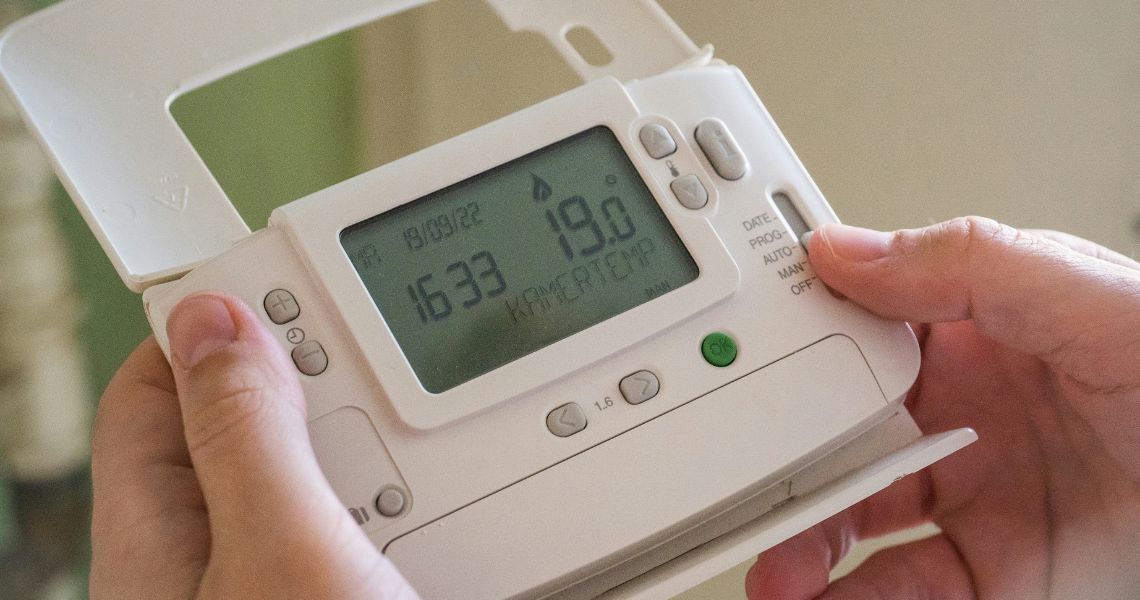Your bedroom walls might hold the secret to the best night’s sleep you’ve ever had. Sounds too good to be true? Studies reveal that people sleeping in blue bedrooms enjoy approximately 7.9 hours of sleep per night, compared to just 6.8 hours for those with purple bedrooms.
The right bedroom colours aren’t just about making your space look beautiful, they’re scientifically proven to affect how well you sleep.
Blue works wonders because it can actually lower your blood pressure and slow down your heart rate, creating the perfect conditions for restful sleep. But here’s the catch: bright, overly stimulating colours work against you, disrupting your natural daily rhythm and making it harder to feel relaxed. When you’re choosing bedroom wall colours, you’re not just picking a shade you like—you’re designing your very own sleep sanctuary.
The science behind bedroom colours is fascinating. Green environments may reduce stress hormones while boosting creative thinking, making them excellent choices for bedroom paint colours. Colour psychologists consistently recommend specific shades for the best bedroom colours for sleep, with green and yellow also showing positive impacts on sleep quality.
So which bedroom colours can give you perfect sleep? Why should certain shades be banned from your bedroom at all costs? And how can you apply these insights to create your ideal sleep environment?
Don’t worry—we’ve got you covered.
The science behind bedroom colours and sleep
The colours surrounding you do far more than simply look pretty. Research in colour psychology shows that the shades in your bedroom significantly affect your mental state, mood, and even your body’s physical responses. Temperature, sound, layout, lighting, and colours all work together to create the perfect sleep environment.
How colour affects the brain and body
Here’s something fascinating: colour isn’t just something you see—your brain actually processes it neurologically. Professor Anna Franklin, a leading expert in colour psychology, explains that “colour preference is driven by how colour is encoded by sensory mechanisms in the eye and brain”. Her groundbreaking research at the University of Sussex’s School of Psychology discovered that dark blue is the world’s most relaxing colour.
Your brain processes colours differently based on their wavelengths. Most people naturally prefer cool-toned colours with shorter wavelengths, like blue, for interior spaces. These colours affect you through both instinctual responses and learned cultural associations.
The physiological effects of bedroom colours are actually measurable:
- Blue may reduce heart rate and blood pressure
- Green promotes feelings of comfort and peace
- Red increases brain activity and heart rate
When your brain encounters stimulating colours like red, your hypothalamus produces more cortisol (a stress hormone) and less melatonin (sleep hormone), resulting in poorer sleep quality. Not exactly what you want when you’re trying to drift off peacefully.
The role of melatonin and circadian rhythm
You have an internal clock—your circadian rhythm—that controls your natural sleep-wake cycle. This biological timekeeper makes you feel awake during daylight hours and sleepy after dark, with light being the most important external factor affecting sleep readiness.
When darkness falls, your pineal gland begins producing melatonin, a hormone that promotes sleepiness. Your body sets this circadian rhythm naturally through the suprachiasmatic nucleus (SCN)—a tiny cluster of cells in your hypothalamus that coordinates physical and mental systems throughout your body.
Light exposure blocks melatonin production, but not all light affects you equally. Room light before bedtime suppresses melatonin onset in 99% of people and shortens melatonin duration by approximately 90 minutes compared to dim light. Even more striking, exposure to room light during normal sleeping hours suppressed melatonin by more than 50% in most trials (85%).
Why bedroom colours matter more than other rooms
Your bedroom serves as your primary sleep sanctuary—the final environment your brain processes before sleep. Since the last thing you see before falling asleep is the atmosphere surrounding you, bedroom colours become far more important than those in other rooms.
Unlike your living room or kitchen, which are designed for activity and socialising, your bedroom needs colours that help transition your brain from wakefulness to sleep. Studies suggest that exposure to calming colours before bedtime can improve melatonin production and reduce cortisol levels.
Here’s a telling statistic: 34% of people identified stress as one of the main causes of poor sleep. Creating a visually calming bedroom becomes essential for quality rest. The best bedroom colours for sleep work by facilitating this crucial transition, helping your brain power down appropriately.
Your bedroom must balance both aesthetic preferences and sleep-promoting properties. Research shows that people exposed to their preferred light colour fell asleep significantly faster (11.8 minutes) compared to those exposed to white light (18.8 minutes). This proves how your personal colour preferences can directly impact how quickly you fall asleep.
8 bedroom colours worth dreaming about
Ready to create your perfect sleep sanctuary? These eight colours have been scientifically proven to promote better sleep, helping you wake up refreshed and ready for the day ahead.
1. Blue – the sleep champion
Blue takes the crown as the ultimate sleep-inducing colour. People sleeping in blue bedrooms enjoyed an impressive 7 hours and 52 minutes of sleep per night. Even better, 55% of those with blue bedrooms reported waking up feeling happy.
The magic happens through specialised ganglion cells in your retinas that are particularly sensitive to blue. When these cells detect this colour, they send calming signals to your brain, reducing blood pressure and slowing heart rate. Choose softer, muted blues with grey or icy undertones rather than bright electric shades for the best results.
2. Green – embrace nature’s calm
Green creates that wonderful connection to nature that instantly makes you feel renewed and balanced. This shade helps lower anxiety and depression rates—both crucial factors for quality sleep. Sage, forest, or pastel greens work beautifully to evoke natural environments without overwhelming your senses.
Green can even help reduce eye strain after long hours of screen time, making it perfect for our device-filled world. Pair with natural materials like wooden furniture or linen bedding for an enhanced nature-inspired sanctuary.

Image credit Bedstar: Divan bed, sage green bedroom décor with lavender and blue accents.
3. Soft grey – your neutral haven
Light grey provides the perfect neutral backdrop that encourages relaxation without overwhelming your senses. This versatile shade creates a serene atmosphere that helps quiet those busy thoughts before bedtime.
Warm-toned greys, light taupe, or gentle greys create a calming, minimalist space that won’t feel stark or cold. For a balanced sleep environment, combine light grey walls with soft textures and perhaps the occasional pop of calming colour.
4. White – clean simplicity
White bedrooms offer timeless tranquillity that never goes out of style. This shade creates a blank canvas that reflects light beautifully, making your space feel larger and brighter. White may promote sleep by stimulating your brain less than more colourful rooms.
Most people associate white with positive words like “peace,” “secure,” and “relaxed”—perfect foundations for rest. Avoid that clinical feel by incorporating different white shades with warm textures like wooden accents or soft fabrics.
5. Beige – warm comfort
Beige brings gentle, natural warmth to your bedroom, creating an atmosphere that feels safe and comforting. This colour manages to be both bright and relaxing—ideal for promoting rest and better sleep.
Beige creates a serene, timeless atmosphere that’s naturally conducive to sleep. Its neutral character pairs wonderfully with natural elements like wood, linen, or rattan for added texture and interest.
6. Pink – surprisingly sophisticated
Pink has evolved far beyond children’s rooms to become a sophisticated choice for adult bedrooms. This colour brings playfulness, sweetness, harmony and romance to your space.
Soft blush pinks feel fresh, soft and romantic, whether you choose a pale, barely-there shade or a deeper hue for more impact. Pair with white for freshness, gold for glamour, or deep navy for striking contrast.
7. Lavender – gentle luxury
Lavender’s benefits extend far beyond its gorgeous hue. This gentle purple has been used as a sleep aid since ancient times, with modern studies confirming its effectiveness.
Lavender creates a soothing environment with proven calming properties. It’s gentle on the eyes, helps reduce visual stimulation, and promotes deep relaxation. This colour works particularly well when paired with natural materials and soft textures.
8. Pale yellow – sunshine serenity

Image credit Bedstar: French inspired bedroom décor, French teal accents, yellow tones, ornate framed mirror, wall sconces, table lamps, light and airy.
Soft yellow creates a warm, comforting atmosphere that genuinely aids peaceful sleep. People sleeping in yellow bedrooms averaged 7 hours and 40 minutes of sleep—the second-highest duration behind blue.
Shade selection matters enormously with yellow. Choose soft, buttery yellows like warm honey or pale lemon that bring just a hint of sunshine without being too bright. Bright or vibrant yellows can increase anxiety and interfere with melatonin production, so always choose gentler tones that feel cheerful yet serene.
The bedroom colours that could ruin your sleep
Some colours can seriously mess with your sleep quality. Just as the right shades create your perfect sleep sanctuary, the wrong ones can keep you tossing and turning all night. Here are the bedroom colours you should avoid at all costs.
Bright red – your sleep’s worst enemy
Red is hands down the worst colour you could choose for your bedroom. This vibrant shade increases heart rate, raises blood pressure, and significantly boosts brain activity. Your body actually responds to red as a potential threat, triggering fight-or-flight responses that keep you wide awake when you desperately need to relax. One study found that red increases brain activity and boosts alertness—exactly what you don’t want before bed.
Neon shades – too intense for any bedroom
Neon colours create such an intense visual experience that they completely disrupt your sleep preparation. These luminous shades directly impact your mood by overstimulating your senses and can even trigger dopamine release, making you feel excited rather than calm. Even if some softer neon blues might seem soothing, most neon shades are simply too intense for bedrooms. Bright yellow, orange or electric blue can overstimulate your visual processing system and mess with melatonin production.
Dark brown – heavy and depressing
Dark brown creates a gloomy atmosphere that works against quality sleep. This shade often increases subconscious feelings of sadness, causing restlessness instead of helping you rest. Colour psychologists warn that dark brown can feel too heavy or oppressive, especially if you have a smaller bedroom. Plus, you’ll probably need to turn on sleep-disrupting bright lights just to navigate a dark brown bedroom at night.
Purple – keeps your mind too active
Here’s where it gets tricky. While lavender can be calming, bold purple tones are problematic for sleep. Bright purple is linked to creativity and imagination—mental activities that might keep your mind racing when it should be winding down. Some studies suggest that purple “stimulates the unconscious mind—thus promoting vivid dreams that some people may find disturbing”. Research found that 33% of people with purple bedrooms reported frequent poor sleep quality.
Already painted your bedroom in one of these colours? Don’t panic. You can either repaint with sleep-friendly alternatives or introduce calming elements through your bedding and accessories to balance things out.

Image credit Bedstar.
How to apply bedroom colours effectively
Choosing the perfect sleep-friendly colour is only half the battle. Even the most soothing shades can work against you if they’re not applied thoughtfully. Your bedroom colour strategy needs to go beyond simply picking up a paintbrush.
Create a statement with accent walls
Want to experiment with bolder colours without overwhelming your sleep sanctuary? An accent wall gives you the perfect opportunity to add personality whilst keeping your space restful. The wall behind your headboard typically works best, framing your bed as the room’s centrepiece . You can play with deeper or more dramatic shades that might feel too intense across four walls, yet still create that visual interest you’re after.
Balance bold with beautiful neutrals
Pairing stronger hues with calming neutrals creates the harmony your bedroom needs for quality sleep. Navy blue walls look stunning when balanced with crisp white furnishings for striking contrast . Or try warming up a soft grey room with muted terracotta accents to make the space feel more welcoming .
Takeaway Tip: using warm neutrals alongside deeper accent colours prevents your bedroom from feeling too stark or cold.
Test your colours properly
Here’s something many people get wrong – paint colours behave completely differently under various lighting conditions. You need to observe your samples throughout an entire day because morning, noon, afternoon and evening light all affect how the colour appears .
Don’t paint testers directly onto your existing walls. The current colour underneath will interfere with how your eye perceives the new shade . Instead, apply samples to poster board, leaving white space between the sample and wall .
Coordinate with your soft furnishings
Your bedroom design starts with the colour scheme, which sets the tone for everything else . Coordinate your wall colours with window dressings, cushions and bedding to create visual cohesion. Pay attention to how your flooring choices complement your walls too – lighter-toned wooden floors can create the illusion of more space .
Match colours to your room
Room size matters when selecting your perfect bedroom colour. Smaller spaces benefit from pale neutrals like light greys that create an illusion of spaciousness . Conversely, darker colours on walls can create depth that cleverly hides compact dimensions .
Natural light exposure determines which shades work best in your specific room. South-facing bedrooms receive warm yellow light, whilst north-facing spaces get cooler blue light . This affects how your chosen colour will actually look once you’re living with it day to day.
Which bedroom colours will work best for you?
Here’s the thing about creating your perfect sleep sanctuary: the science gives you a brilliant starting point, but your personal connection to colour is what makes the magic happen.
What do colours mean to you?
The Ecological Valence Theory explains why you naturally gravitate towards certain shades—your colour preferences come from emotional responses to colour-associated objects. You prefer colours linked to things you love. Blue often wins because of its positive associations with water—something vital for survival. Your brain processes colours differently based on their wavelengths, and typically cool-toned colours with shorter wavelengths promote more positive emotions.
Your background shapes your preferences
Cultural background plays a huge role in how you respond to different colours. Eastern cultures often associate red with good fortune, whilst Western traditions connect it to passion or danger. Even your geographic location influences what feels right—tropical regions favour vibrant tones, desert communities gravitate toward warm hues, coastal areas prefer blues. Remember, your unique life experiences might override general colour psychology principles.
Finding YOUR perfect sleep colour
Test potential bedroom paint colours under evening lighting conditions—this is when you’ll actually be using your bedroom for sleep. The most important consideration? Finding colours that personally help you relax. Your perfect colour combination should make you feel comfortable and at peace. After all, your bedroom is your haven.
Don’t feel pressured to choose blue just because the research says it’s best. If soft green makes your heart sing, or gentle beige feels like a warm hug, trust those instincts. The perfect bedroom colour is one that combines sleep science with what makes YOU feel truly relaxed.
Your bedroom colour choices can change everything
Choosing the right bedroom colour is one of the most powerful tools you have for better sleep. Blue consistently delivers the best results, giving many people nearly 8 hours of sleep per night. Green, soft grey, and gentle neutrals also create the perfect foundation for restful nights.
Your bedroom colours do far more than look good—they directly affect your body’s responses and melatonin production. That’s why avoiding stimulating shades like bright red, neon colours, dark brown, and bold purple becomes just as important when you’re creating your sleep sanctuary.
But here’s what matters most: your personal preference still counts. The most effective bedroom colour combines sleep science with what makes YOU feel relaxed. Your bedroom should be your personal haven—a space that calms your mind and reflects your individual style.
Remember to test your chosen colours under evening light to make sure they keep their soothing properties when you need them most. And don’t forget—you can always use accent walls to add visual interest without overwhelming your space.
Whether you choose calming blue, natural green, or soft neutrals, your bedroom walls can become your greatest allies for perfect sleep. So why not start your Weekend Project today? Your body and mind will thank you for it.
Don’t forget, you can use colour visualisation tools to bring your bedroom ideas to life before you commit to painting your entire space.
Key Takeaways
Transform your sleep quality by choosing scientifically-backed bedroom colours that promote relaxation and support your natural circadian rhythm.
• Blue bedrooms deliver the best sleep results, with users averaging 7.9 hours nightly compared to 6.8 hours in purple rooms
• Avoid bright red, neon shades, and bold purple as they increase heart rate and stimulate brain activity when you need rest
• Test paint colours under evening lighting conditions since bedroom colours must work effectively during your actual sleep hours
• Balance personal colour preferences with sleep science by choosing shades that make you feel personally relaxed and comfortable
• Use accent walls for bolder colours whilst keeping main walls in calming neutrals like soft grey, green, or gentle beige
The most effective bedroom colour isn’t just about following trends—it’s about creating a personalised sleep sanctuary that combines proven colour psychology with your individual emotional responses to different hues.
Images supplied – see individual credits












